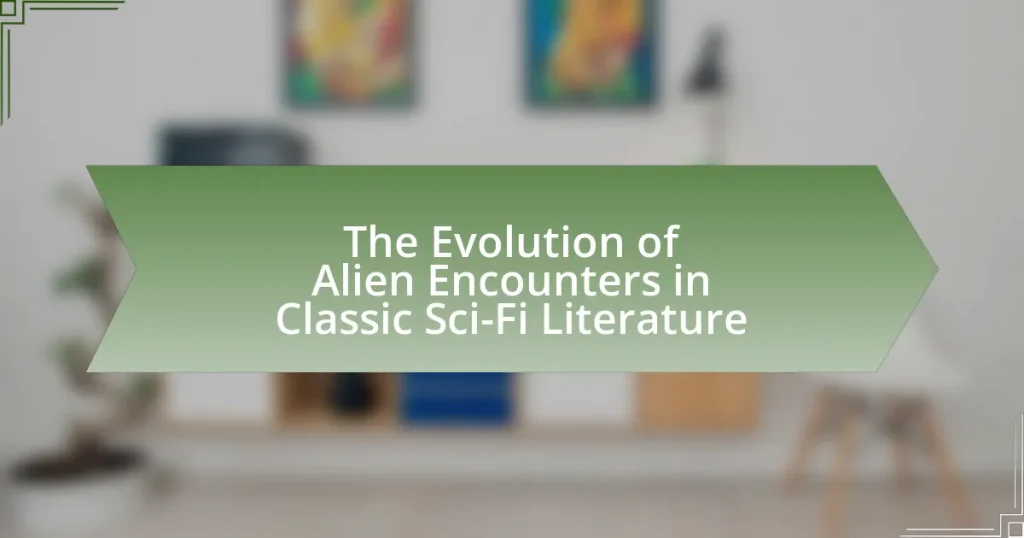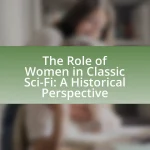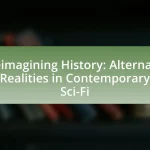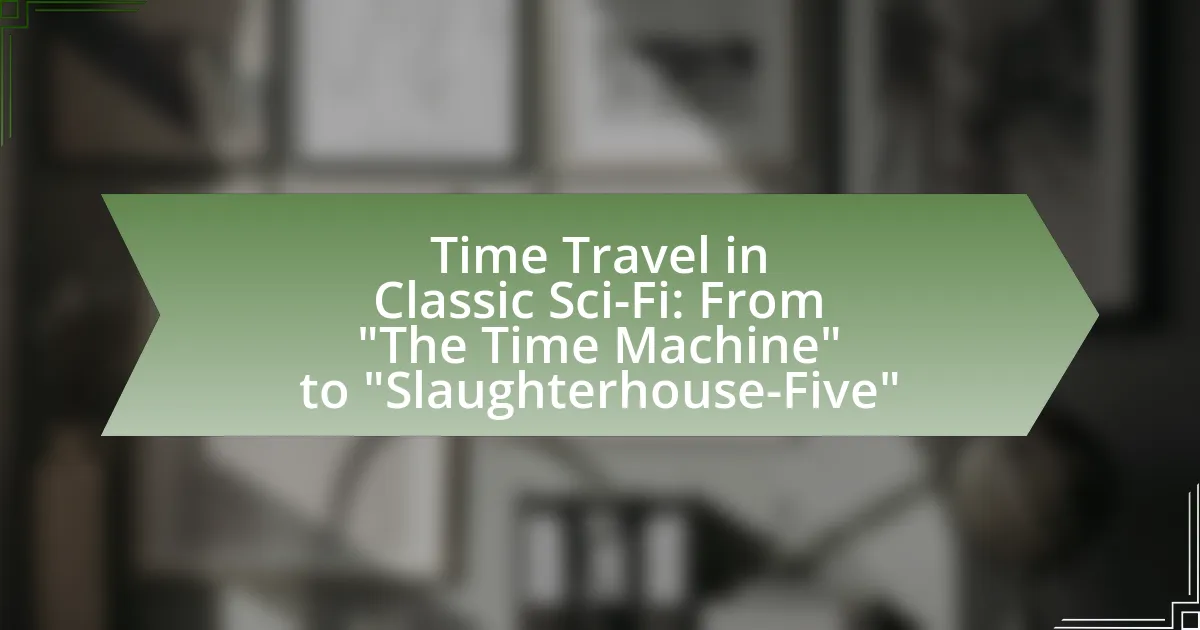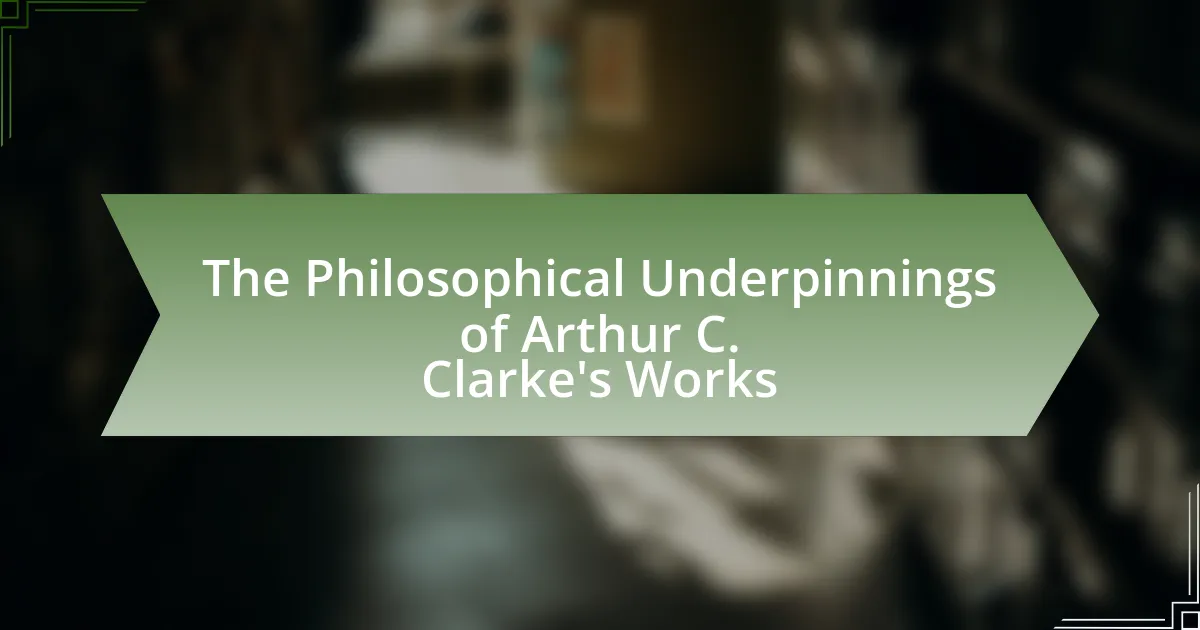The article examines the evolution of alien encounters in classic sci-fi literature, highlighting their significance in exploring human nature, societal fears, and the unknown. It traces the historical milestones in the portrayal of aliens, from hostile invaders in H.G. Wells’ “The War of the Worlds” to benevolent beings in Arthur C. Clarke’s “Childhood’s End.” The discussion includes how societal changes influence these depictions, the thematic exploration of communication and coexistence, and the impact of key authors on the genre. Additionally, it addresses the literary devices used to enhance narratives and the lessons modern writers can learn from classic works.

What is the significance of alien encounters in classic sci-fi literature?
Alien encounters in classic sci-fi literature serve as a critical device for exploring human nature, societal fears, and the unknown. These encounters often reflect contemporary anxieties about technology, colonialism, and the potential for conflict with other civilizations. For instance, H.G. Wells’ “The War of the Worlds” illustrates Victorian fears of invasion and the consequences of imperialism, while Arthur C. Clarke’s “Childhood’s End” examines themes of transcendence and the evolution of humanity in the face of superior intelligence. Such narratives not only entertain but also provoke thought about humanity’s place in the universe, ethical dilemmas, and the future of civilization, making alien encounters a significant element in the thematic depth of classic sci-fi literature.
How have alien encounters evolved over time in this genre?
Alien encounters in classic sci-fi literature have evolved from initial depictions of extraterrestrials as hostile invaders to more complex portrayals that explore themes of communication and coexistence. Early works, such as H.G. Wells’ “The War of the Worlds” (1898), presented aliens as aggressive beings intent on conquering Earth. In contrast, later literature, exemplified by Arthur C. Clarke’s “Childhood’s End” (1953), introduced aliens as benevolent entities that facilitate human evolution and understanding. This shift reflects broader societal changes, including the Cold War’s impact on perceptions of the ‘other’ and the growing interest in peaceful exploration and cooperation in the face of existential threats.
What are the key historical milestones in the portrayal of aliens?
The key historical milestones in the portrayal of aliens include the publication of H.G. Wells’ “The War of the Worlds” in 1898, which introduced the concept of hostile extraterrestrial beings invading Earth. This was followed by the 1920 play “R.U.R.” by Karel Čapek, which popularized the term “robot” and explored themes of artificial life and alien intelligence. In 1950, the film “The Day the Earth Stood Still” presented a more benevolent view of aliens, emphasizing peace and warning against humanity’s destructive tendencies. The 1960s saw the rise of the “Star Trek” series, which depicted diverse alien cultures and promoted a message of exploration and understanding. Finally, the 1977 release of “Star Wars” revolutionized the portrayal of aliens in popular culture, showcasing a wide array of alien species and complex intergalactic societies. These milestones reflect the evolving perceptions of aliens from threats to allies and complex beings within the narrative of science fiction.
How do societal changes influence the depiction of alien encounters?
Societal changes significantly influence the depiction of alien encounters by reflecting contemporary fears, values, and technological advancements. For instance, during the Cold War era, alien narratives often embodied themes of paranoia and distrust, mirroring societal anxieties about communism and nuclear warfare, as seen in works like “The Day the Earth Stood Still” (1951). In contrast, the rise of environmentalism in the 1970s led to portrayals of aliens as potential saviors or warnings about ecological destruction, evident in films like “Silent Running” (1972). These shifts illustrate how the context of the time shapes the characteristics and roles of extraterrestrial beings in literature and film, making them a mirror of human concerns and aspirations.
Why are alien encounters a central theme in classic sci-fi literature?
Alien encounters are a central theme in classic sci-fi literature because they explore humanity’s relationship with the unknown and reflect societal fears and aspirations. Classic works, such as H.G. Wells’ “The War of the Worlds,” illustrate the anxiety surrounding imperialism and the potential for invasion, while Arthur C. Clarke’s “Childhood’s End” examines themes of evolution and transcendence. These narratives often serve as allegories for contemporary issues, such as colonization, technological advancement, and existential threats, making them relevant across different eras. The prevalence of alien encounters in these texts underscores their role in prompting readers to question their place in the universe and the nature of humanity itself.
What themes do alien encounters typically explore?
Alien encounters typically explore themes of communication, fear of the unknown, and the nature of humanity. These themes reflect the complexities of interaction between humans and extraterrestrial beings, often highlighting the challenges of understanding and interpreting alien motives. For instance, classic sci-fi literature frequently portrays alien encounters as a metaphor for societal anxieties, such as the fear of invasion or the consequences of technological advancement. Works like H.G. Wells’ “The War of the Worlds” illustrate the theme of fear through the depiction of hostile aliens, while Arthur C. Clarke’s “Childhood’s End” explores the theme of communication and understanding, emphasizing the transformative impact of alien contact on human society.
How do alien encounters reflect human fears and aspirations?
Alien encounters reflect human fears and aspirations by serving as a mirror for societal anxieties and hopes regarding the unknown. For instance, classic sci-fi literature often portrays aliens as either threatening invaders or benevolent beings, illustrating humanity’s fear of the other and desire for connection. Works like H.G. Wells’ “The War of the Worlds” depict aliens as destructive forces, symbolizing fears of imperialism and loss of control, while Arthur C. Clarke’s “Childhood’s End” presents aliens as guides to a higher state of existence, reflecting aspirations for transcendence and unity. These narratives highlight how alien encounters encapsulate the duality of human experience, balancing dread of the unfamiliar with the yearning for exploration and understanding.

What are the different types of alien encounters depicted in classic sci-fi literature?
Classic sci-fi literature depicts several types of alien encounters, primarily categorized into three types: hostile, benevolent, and neutral. Hostile encounters often involve aliens as antagonists, exemplified in H.G. Wells’ “The War of the Worlds,” where Martians invade Earth with destructive intent. Benevolent encounters portray aliens as helpers or guides, as seen in Arthur C. Clarke’s “Childhood’s End,” where extraterrestrials assist humanity in transcending its limitations. Neutral encounters typically involve aliens that are indifferent to human affairs, illustrated in Isaac Asimov’s “The Gods Themselves,” where alien beings exist in parallel universes without direct interaction with humans. These classifications highlight the diverse ways authors explore the implications of extraterrestrial life and its impact on humanity.
How do friendly alien encounters differ from hostile ones?
Friendly alien encounters are characterized by cooperation and mutual understanding, while hostile encounters involve aggression and conflict. In classic sci-fi literature, friendly aliens often assist humanity, as seen in works like “The Day the Earth Stood Still,” where the alien Klaatu seeks to promote peace. Conversely, hostile encounters, such as those depicted in “War of the Worlds,” showcase aliens as invaders intent on destruction. These differing portrayals reflect humanity’s hopes and fears regarding the unknown, influencing the narrative direction and themes of the stories.
What are some notable examples of friendly alien encounters?
Notable examples of friendly alien encounters in classic sci-fi literature include the interactions between humans and the aliens in “The Day the Earth Stood Still” by Harry Bates, where the alien Klaatu seeks to promote peace and understanding. Another example is in “Contact” by Carl Sagan, where the protagonist, Ellie Arroway, communicates with an advanced extraterrestrial intelligence that shares knowledge and promotes cooperation. Additionally, in “The Left Hand of Darkness” by Ursula K. Le Guin, the protagonist forms a bond with the alien Genly Ai, emphasizing themes of friendship and mutual respect. These examples illustrate the portrayal of aliens as benevolent beings, fostering themes of unity and understanding in the genre.
What are the implications of hostile alien encounters in literature?
Hostile alien encounters in literature often serve as a reflection of societal fears and anxieties regarding the unknown, particularly in the context of colonization, war, and technological advancement. These narratives frequently explore themes of existential threat, highlighting humanity’s vulnerability and the moral dilemmas associated with conflict. For instance, H.G. Wells’ “The War of the Worlds” illustrates the fear of imperialism and the consequences of invasion, while also prompting readers to consider the ethical implications of humanity’s own colonial actions. Such literature not only entertains but also critiques human behavior, encouraging reflection on our responses to perceived threats and the nature of otherness.
What role do aliens play in the development of sci-fi narratives?
Aliens serve as pivotal catalysts in the development of sci-fi narratives by embodying the exploration of the unknown and challenging human perspectives. Their presence often facilitates themes of conflict, cooperation, and existential inquiry, allowing authors to examine societal issues through allegory. For instance, H.G. Wells’ “The War of the Worlds” illustrates colonial anxieties and human vulnerability through the invasion of Martians, while Arthur C. Clarke’s “Childhood’s End” explores the evolution of humanity in the face of superior extraterrestrial intelligence. These narratives not only entertain but also provoke critical thought about humanity’s place in the universe, reflecting cultural fears and aspirations.
How do aliens serve as catalysts for character development?
Aliens serve as catalysts for character development by challenging human characters to confront their beliefs, fears, and moral dilemmas. In classic sci-fi literature, encounters with extraterrestrial beings often force protagonists to reevaluate their identities and values, leading to significant personal growth. For example, in Arthur C. Clarke’s “Childhood’s End,” the arrival of the Overlords compels humanity to transcend its limitations, prompting characters to grapple with existential questions about purpose and evolution. This interaction with aliens not only drives the plot but also deepens the psychological complexity of characters, illustrating how external forces can provoke internal transformation.
What narrative techniques are used to portray alien encounters?
Narrative techniques used to portray alien encounters include first-person perspectives, unreliable narrators, and vivid imagery. First-person perspectives allow readers to experience the encounter through the eyes of a character, creating an intimate connection and heightening emotional responses. Unreliable narrators introduce ambiguity, prompting readers to question the authenticity of the encounter, which adds layers of complexity to the narrative. Vivid imagery enhances the portrayal of alien beings and environments, making them more tangible and immersive for the reader. These techniques have been effectively utilized in classic sci-fi literature, such as H.G. Wells’ “The War of the Worlds,” where the first-person narrative immerses readers in the chaos of an alien invasion, and Arthur C. Clarke’s “Childhood’s End,” which employs vivid descriptions to evoke the otherworldly nature of the alien species.
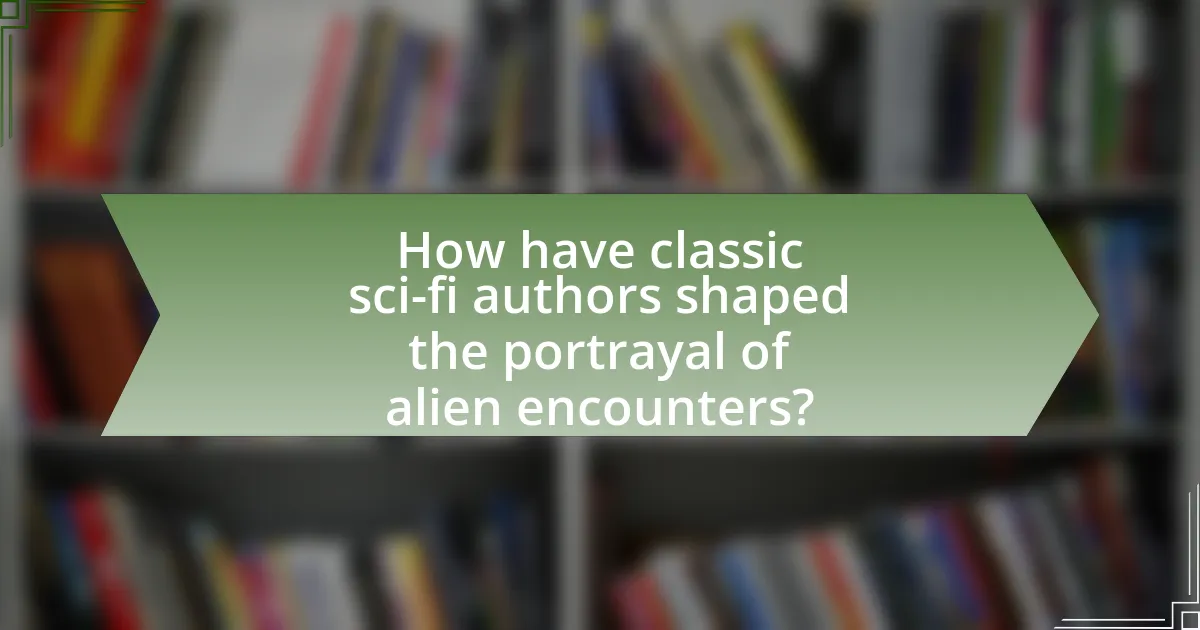
How have classic sci-fi authors shaped the portrayal of alien encounters?
Classic sci-fi authors have significantly shaped the portrayal of alien encounters by introducing diverse and complex representations of extraterrestrial life. For instance, H.G. Wells’ “The War of the Worlds” depicted aliens as hostile invaders, influencing public perception of extraterrestrial encounters as potentially dangerous. Similarly, Arthur C. Clarke’s “Childhood’s End” presented aliens as benevolent overseers, challenging the notion of fear and conflict. These contrasting depictions have established a framework for understanding alien encounters in literature, reflecting societal anxieties and aspirations. The impact of these authors is evident in the lasting themes of conflict, coexistence, and the unknown that continue to resonate in contemporary sci-fi narratives.
What are the contributions of key authors to the evolution of alien encounters?
Key authors have significantly shaped the evolution of alien encounters in classic sci-fi literature through their innovative narratives and thematic explorations. H.G. Wells, in “The War of the Worlds,” introduced the concept of extraterrestrial invasion, reflecting societal fears of imperialism and the unknown. Arthur C. Clarke’s “Childhood’s End” explored themes of transcendence and the impact of advanced alien civilizations on humanity, emphasizing philosophical questions about evolution and identity. Philip K. Dick’s works, such as “The Man in the High Castle,” often blurred the lines between reality and perception, challenging readers to consider the nature of existence in a universe that may include alien influences. These authors not only expanded the genre’s boundaries but also influenced cultural perceptions of alien life, making their contributions foundational to the discourse on extraterrestrial encounters in literature.
How did H.G. Wells influence the depiction of aliens?
H.G. Wells significantly influenced the depiction of aliens by introducing complex, often malevolent extraterrestrial beings in his works, particularly in “The War of the Worlds.” This novel, published in 1898, presented aliens as advanced, technologically superior invaders, challenging the notion of humanity’s dominance. Wells’ portrayal of Martians as both intelligent and ruthless set a precedent for future science fiction, emphasizing themes of invasion and existential threat. His work prompted subsequent authors to explore the moral and ethical implications of alien encounters, shaping the narrative framework for alien representation in literature and media.
What impact did Arthur C. Clarke have on the understanding of alien intelligence?
Arthur C. Clarke significantly advanced the understanding of alien intelligence through his exploration of complex extraterrestrial life forms and their potential interactions with humanity. In works like “2001: A Space Odyssey,” Clarke presented the idea that alien intelligence could be vastly different from human cognition, emphasizing the importance of communication and the limitations of human understanding. His concept of the monolith as a tool for evolution and knowledge transfer illustrates the potential for advanced civilizations to influence humanity’s development. Clarke’s scientific approach, combined with philosophical inquiry, encouraged readers and scientists alike to consider the implications of encountering intelligent life beyond Earth, shaping both popular and academic discourse on the subject.
What literary devices are commonly used in alien encounter stories?
Alien encounter stories commonly utilize literary devices such as symbolism, foreshadowing, and personification. Symbolism often represents the alien as a reflection of human fears or aspirations, enhancing thematic depth. For example, in H.G. Wells’ “The War of the Worlds,” the Martians symbolize colonial fears and the unknown. Foreshadowing builds tension and anticipation, as seen in Arthur C. Clarke’s “Childhood’s End,” where early hints suggest the profound impact of the alien presence on humanity. Personification gives aliens human-like traits, making them relatable or terrifying, as illustrated in Ray Bradbury’s “The Martian Chronicles,” where Martians exhibit complex emotions. These devices enrich the narrative and engage readers by exploring the implications of extraterrestrial life.
How does symbolism enhance the meaning of alien encounters?
Symbolism enhances the meaning of alien encounters by providing deeper layers of interpretation that reflect human emotions, societal fears, and existential questions. For instance, in classic sci-fi literature, aliens often symbolize the unknown or the ‘other,’ representing humanity’s anxieties about cultural differences and the potential for conflict. A concrete example is H.G. Wells’ “The War of the Worlds,” where Martians symbolize imperialism and the fear of invasion, illustrating the consequences of colonial attitudes. This use of symbolism allows readers to engage with complex themes such as identity, morality, and the nature of humanity, making alien encounters not just a narrative device but a profound commentary on human experience.
What role does foreshadowing play in alien encounter narratives?
Foreshadowing in alien encounter narratives serves to build suspense and prepare the audience for future events. By subtly hinting at potential dangers or revelations, foreshadowing creates an atmosphere of tension that enhances the overall impact of the story. For example, in H.G. Wells’ “The War of the Worlds,” early descriptions of strange meteorological phenomena foreshadow the impending arrival of Martians, effectively heightening reader anticipation. This technique not only engages the audience but also enriches the narrative by providing layers of meaning that can be revisited as the plot unfolds.
What lessons can modern writers learn from classic alien encounters?
Modern writers can learn the importance of exploring themes of humanity and morality from classic alien encounters. Classic works, such as H.G. Wells’ “The War of the Worlds,” illustrate how alien interactions often serve as a mirror reflecting human nature, societal fears, and ethical dilemmas. These narratives encourage writers to delve into the complexities of human emotions and relationships when faced with the unknown. Additionally, classic alien encounters often emphasize the significance of communication and misunderstanding, as seen in Arthur C. Clarke’s “Childhood’s End,” where the arrival of aliens leads to profound changes in human society. This highlights the need for modern writers to consider the implications of dialogue and cultural exchange in their narratives. By integrating these lessons, contemporary authors can create richer, more thought-provoking stories that resonate with readers on multiple levels.
How can contemporary authors effectively portray alien encounters?
Contemporary authors can effectively portray alien encounters by utilizing diverse narrative techniques, such as character-driven perspectives, cultural parallels, and scientific plausibility. By focusing on characters’ emotional responses and ethical dilemmas during these encounters, authors create relatable experiences that resonate with readers. For instance, the use of cultural parallels allows authors to explore themes of communication and misunderstanding, reflecting real-world issues of xenophobia and acceptance. Additionally, grounding alien encounters in scientific plausibility enhances believability, as seen in works like “The Three-Body Problem” by Liu Cixin, which incorporates astrophysics to frame its narrative. This combination of character depth, thematic relevance, and scientific accuracy enables contemporary authors to craft compelling and thought-provoking portrayals of alien encounters.
What themes from classic alien encounters remain relevant today?
Themes from classic alien encounters that remain relevant today include the fear of the unknown, the exploration of humanity’s place in the universe, and the ethical implications of contact with extraterrestrial life. The fear of the unknown is exemplified in works like H.G. Wells’ “The War of the Worlds,” where alien invasion evokes anxiety about invasion and loss of control. The exploration of humanity’s place in the universe is highlighted in Arthur C. Clarke’s “2001: A Space Odyssey,” which raises questions about evolution and intelligence. Ethical implications are evident in stories like “The Day the Earth Stood Still,” where the consequences of human actions are examined through the lens of alien perspectives. These themes continue to resonate as they reflect ongoing societal concerns about technology, environmental issues, and the potential for contact with intelligent life beyond Earth.
